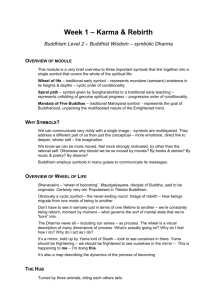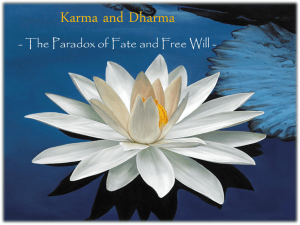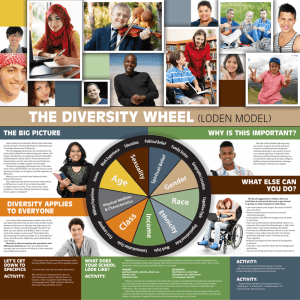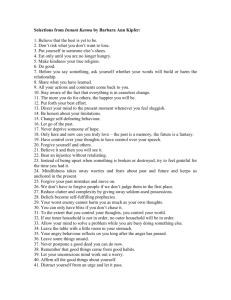Overview of Wheel of Life
advertisement
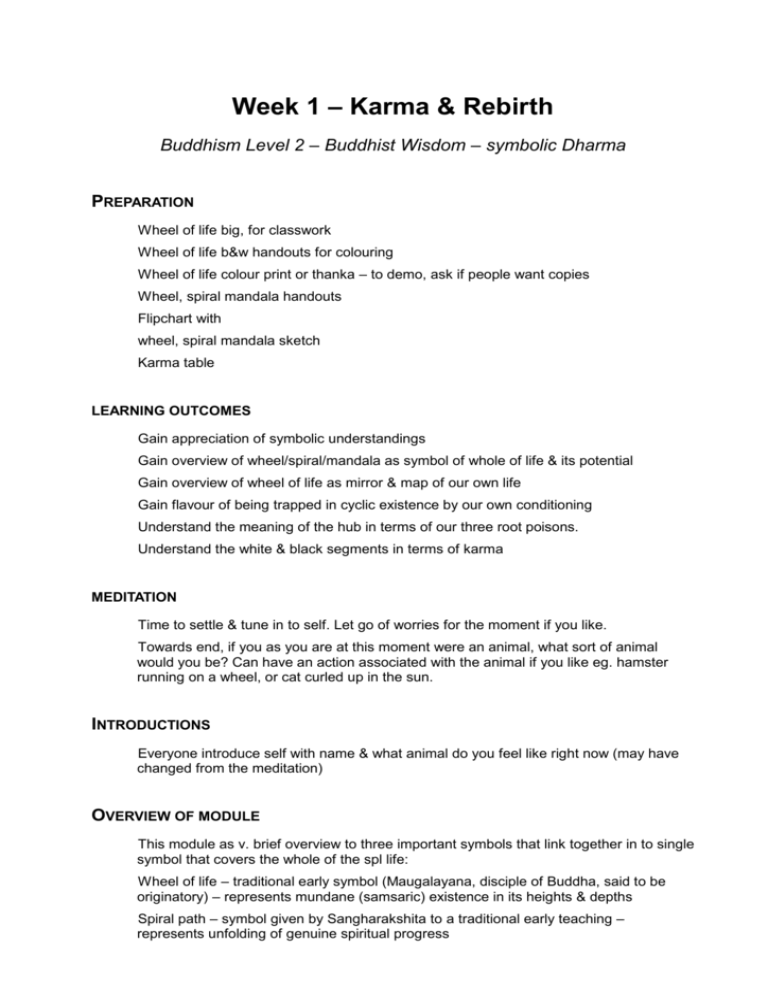
Week 1 – Karma & Rebirth Buddhism Level 2 – Buddhist Wisdom – symbolic Dharma PREPARATION Wheel of life big, for classwork Wheel of life b&w handouts for colouring Wheel of life colour print or thanka – to demo, ask if people want copies Wheel, spiral mandala handouts Flipchart with wheel, spiral mandala sketch Karma table LEARNING OUTCOMES Gain appreciation of symbolic understandings Gain overview of wheel/spiral/mandala as symbol of whole of life & its potential Gain overview of wheel of life as mirror & map of our own life Gain flavour of being trapped in cyclic existence by our own conditioning Understand the meaning of the hub in terms of our three root poisons. Understand the white & black segments in terms of karma MEDITATION Time to settle & tune in to self. Let go of worries for the moment if you like. Towards end, if you as you are at this moment were an animal, what sort of animal would you be? Can have an action associated with the animal if you like eg. hamster running on a wheel, or cat curled up in the sun. INTRODUCTIONS Everyone introduce self with name & what animal do you feel like right now (may have changed from the meditation) OVERVIEW OF MODULE This module as v. brief overview to three important symbols that link together in to single symbol that covers the whole of the spl life: Wheel of life – traditional early symbol (Maugalayana, disciple of Buddha, said to be originatory) – represents mundane (samsaric) existence in its heights & depths Spiral path – symbol given by Sangharakshita to a traditional early teaching – represents unfolding of genuine spiritual progress Mandala of Five Buddhas – traditional Mahayana symbol - represents the goal of Buddhahood, unpacking the multifaceted nature of the Enlightened mind. For those on previous modules, will be recapitulating some of the earlier concepts, now represented symbolically. WHY SYMBOLS? Refer back to “animal” exercise. We can communicate very richly with a single image – multilayered. Addresses a different part of us than just the conceptual – more emotional, direct link to deeper, wholer self. We know we can be more moved, feel more strongly motivated, by other than the rational self. Otherwise why should we be so moved by movies? By books & stories? By music & poetry? By dreams? Why should millions of people grieve for someone they never met when Princess Diana was killed? Buddhism employs symbols in many guises to communicate it’s messages. OVERVIEW OF WHEEL OF LIFE Bhavacakra – wheel of becoming Obviously a cyclic symbol – the never-ending round [Guided tour of the different aspects of the wheel] “escape from castle” computer game point isn’t to amass lots of points for its own sake, but to escape altogether Image of rebirth – How beings migrate from one mode of being to another Don’t have to see it narrowly just in terms of one lifetime to another – we’re constantly being reborm, moment by moment – what governs the sort of mental state that we’re “born” into. The Dharma views all – including our selves – as process The WoL is a visual description of many dimensions of process What’s actually going on? Why do I feel how I do? Why do I act as I do? It’s a mirror, held up by Yama lord of Death – look to see ourself in there Yama should be frightening – we should be frightened to see ourselves in the mirror – This is happening to me – I’m doing this It’s also a map describing the dynamics of the process of becoming THE HUB Cock – greedily pecking for food - lust or craving Snake – image of malicious harm – hatred or aversion Pig – eyes obscured by ears – ignorance or delusion [don’t get too hung up on biological accuracy! Just relate to the image] These are the driving forces of the wheel – of the reactive mind 2 And the sources of our suffering But its counterproductive to respond with aversion to our nature - Accept our basically animal natures & animal drives Not at war with self, but look for ways to accommodate & go beyond limitations. We have that possibility because of self-consciousness & if believe Buddha, we have that potential in us We have potential for the opposites of the poisons Generosity / contentment, love, wisdom Can contact the innate knowledge that these qualities are wholesome – don’t need to justify it rationally because we know they are good when we experience them – could call that an aspect of our Buddha nature. T E A B R E A K ORGANISATIONAL DETAILS Dana appeal – recommend £5-7 per night Mailing list – any interest? VP will send out invitations to join the Yahoo Group. Can always unsubscribe. Want an A4 copy of wheel of life? THE BLACK & WHITE SEGMENTS Beings evolving according to their karma Skilful actions tending towards pleasant, happy outcomes; unskilful tending towards unpleasant, painful outcomes Stark – all the time only have two choices – skilful or unskilful Not to say there’s only two different things we can do, but have the choice between those trends of conditionality. Of course, not always that black & white Sobering – do we tend to think that most of what we do is somehow “neutral”, won’t really make a difference somehow? KARMA Everything we do affects us, modifies our being in some way Karma is a model that explains how: Actions (of body speech or mind) motivated by the poisons (greed, hatred, delusion) tend to lead to unhappy states of being & consciousness. Termed “skilful” Actions (of body speech or mind) motivated by generosity, love, wisdom tend to lead to happy states of being and consciousness. Termed “unskilful” Flipchart: 3 Underlying motivation Karmic quality Outcome Greed, hatred, delusion Unskilful Unhappy – lower state of being Generosity, love, wisdom Skilful Happier – higher state of being Those on last module will remember that karma is one aspect of conditionality. Not everything that happens to us is caused by our karma, but everything we do say or think will have an effect, certainly on us and probably on the world around us. There’s no Supreme Being administering justice: karma is a model that describes the natural workings of the psychical universe. So we talk of skilful and unskilful rather than good & bad: there’s no one “up there” judging us, to whom we’re responsible. Confidence in karma is one of chiefs objects of faith for a Buddhist – to extent that really at gut level believe that actions have consequences, will be that much more motivated & energised to practice. Most reluctance or lack of energy in practice / meditation is really just doubt – lack of conviction that it will make a difference, or that one’s current disengaged mental state is at best a missed opportunity. Karma is our one true possession: Beings are owners of their karma, heirs of their karma, karma is the womb from which they are born. Their karma is their friend and their refuge. Whatever karma they perform, good or bad, of that they will be heirs Majjhima Nikaya 135 Defines us and our future happiness more strongly than our possessions, our likes & dislikes, our looks, our family, wealth etc REBIRTH Want to keep it practical, so no point getting too speculative about rebirth, but… If see ourselves as a process of continual change, one moment of being conditioning the next, then not such a big deal to see the end of one life conditioning the beginning of the next. No fixed “I” that moves from one to the next, but tendencies conditioning tendencies Exercise Think of a skilful habit and an unskilful habit that you have sometimes. Good: eg. meditating each day, making cups of tea for colleagues, being patient with your kid, being appreciative of your friends/family… Bad: eg getting angry while driving, getting wound up by a particular family member, nursing resentful thoughts about someone, overindulging in cake…. How do you know it is a good or bad habit? How do you feel afterwards? Think about qualities such as: content or edgy; expansive or constricted; connected or isolated; happy or unhappy. 4 HOME PRACTICE Trying to gain a sense of how we’re “reborn” each moment depending on our karma: Try to notice a couple of times per day moments of karma (we’re doing it all the time!), and work out whether you’re in the black or white segment. If you’re “in the white”, ie being aware, skilful & creative, then you’ll probably notice it as you’re doing it. If you’re in the black, ie being unskilful & reactive, then you may not realise until afterwards, maybe by how you feel. Is there any connection between how you feel later and the quality of the karma? And, if you like, start colouring in your wheel of life! RESOURCES FOR THE COURSE On the web Interactive wheel of life (needs Explorer) http://www.angelfire.com/yt/fairtibet/whexpl.html More detailed wheel of life exposition with good images http://www.kheper.net/topics/Buddhism/wheeloflife.html Sutta and essay on how the wheel & spiral path are connected: http://accesstoinsight.org/lib/authors/bodhi/wheel277.html Recommended books The Wheel of Life, Kulananda (short & pithy) ch 1-3 The Buddhist Vision, Subhuti (more in-depth, covers whole module) ch 4 & 5 Karma & Rebirth, Nagapriya (contemporary, critical account) Other What is the Dharma, Sangharakshita, ch 2 Karma & Rebirth, Sangharakshita, CD 032 5

